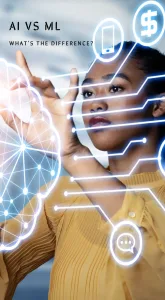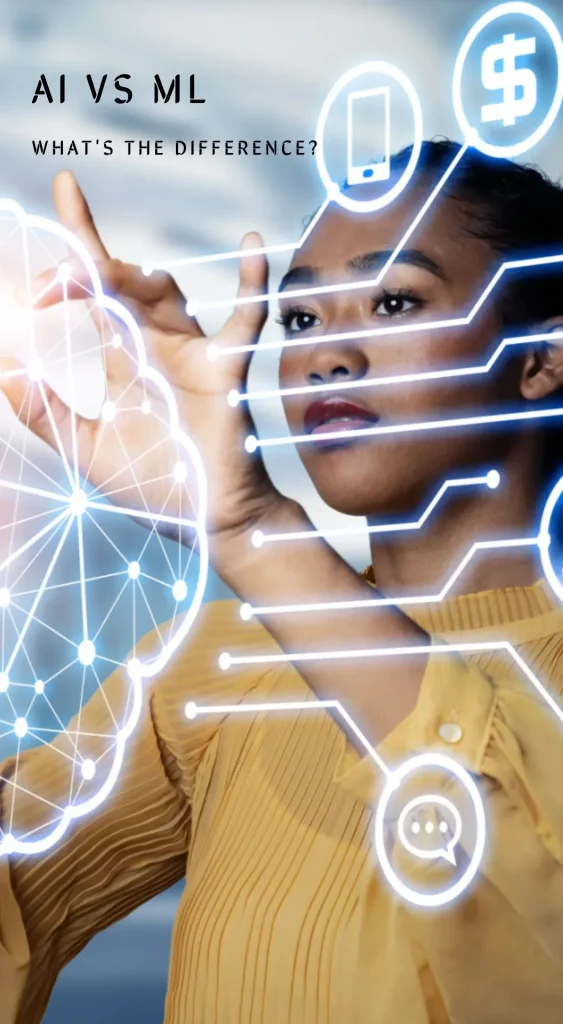Picture this: You’re scrolling through your social media feed and stumble upon an article claiming that AI will soon take over the world. Or, you hear about a breakthrough in ML that has the potential to revolutionise the way we live. These exciting and sometimes alarming headlines often leave us with more questions than answers. What is the difference between AI and ML? How do they work, and what benefits do they offer? What are the potential risks and challenges, and how can they be addressed? In this blog post, we’ll dive into these intriguing questions, guided by insights from renowned AI expert, Professor Michael I. Jordan from the University of California, Berkeley.
AI vs. ML: Demystifying the Differences
 AI, or artificial intelligence, is a broad field that focuses on creating intelligent machines capable of performing tasks that typically require human intelligence, such as visual perception, speech recognition, decision-making, and natural language processing. It’s like creating a digital brain that can think, learn, and make decisions based on input data.
AI, or artificial intelligence, is a broad field that focuses on creating intelligent machines capable of performing tasks that typically require human intelligence, such as visual perception, speech recognition, decision-making, and natural language processing. It’s like creating a digital brain that can think, learn, and make decisions based on input data.
ML, or machine learning, on the other hand, is a specific subfield of AI that involves teaching machines to learn from data without being explicitly programmed. It’s akin to giving that digital brain a set of tools and techniques to identify patterns, trends, and relationships in data, which it can then use to make predictions and decisions.
Think of AI as the overarching umbrella, with ML being one of the many techniques that fall under it. To avoid confusion and foster a deeper understanding, it’s essential to recognise that ML is not synonymous with AI, but rather a subset of it.
The Magic of AI and ML: Real-World Applications and Benefits
Now that we’ve distinguished between AI and ML, let’s explore some of their fascinating real-world applications and the benefits they bring to our lives.
AI has made incredible strides in recent years, leading to applications like facial recognition features on smartphones, personalised online shopping experiences, virtual assistants in our homes, and even medical diagnosis of diseases. These innovations have the potential to enhance our daily lives, streamline processes, and improve decision-making across various industries.
ML, with its ability to learn from data, has also given rise to numerous applications, such as fraud detection in financial transactions, supply chain optimisation in manufacturing and health care, and content personalisation in media and entertainment. These applications not only provide valuable insights and predictions but also help automate tasks, saving time and resources.
Navigating the Maze: Avoiding Confusion Between AI and ML
The media and the tech industry often use AI and ML interchangeably, leading to misconceptions and unrealistic expectations about their capabilities and limitations. To navigate this maze of confusion, it’s essential to remember that ML is a specific technique within the broader field of AI, not a synonym.
By clearly communicating these distinctions and fostering a deeper understanding of AI and ML, we can prevent misunderstandings and ensure that the true potential of these powerful technologies is recognised and harnessed.
The Flip Side: Challenges and Risks of AI and ML
As we marvel at the incredible benefits and applications of AI and ML, it’s crucial to also consider the challenges and risks that accompany them. According to Professor Jordan, the main challenge of AI and ML is to build planetary-scale systems that actually work, deliver value to humans, and do not amplify inequities. This requires a new engineering discipline that is human-centric and focuses on the interface between people and technology.
Some potential risks associated with the development and use of AI and ML include job displacement due to automation, the impact on human autonomy and decision-making due to reliance on machines, and ethical issues related to data privacy, security, fairness, and accountability. These challenges and risks warrant careful consideration and a responsible approach to harnessing the power of AI and ML.
Walking the Tightrope: Addressing the Challenges and Risks Responsibly and Ethically
To tackle these challenges and risks, we must adopt a balanced, responsible, and ethical approach. Here are some key strategies to ensure that AI and ML are developed and implemented in a way that benefits society as a whole:
Focus on building systems that work reliably and efficiently in real-world situations, with the ability to handle uncertainty and complexity.
Develop AI and ML systems that deliver value to humans and meet their needs and preferences by understanding the human context and incorporating human feedback and guidance.
Ensure that AI and ML systems are fair, transparent, accountable, and respectful of human dignity and rights to prevent unintended consequences and negative impacts on society, especially on vulnerable and marginalised groups.
Conclusion
In this blog post, we’ve unravelled the mysteries of AI and ML, demystifying their differences, exploring their applications and benefits, and delving into the challenges and risks they pose. By understanding these distinctions and adopting a responsible and ethical approach, we can harness the power of AI and ML to improve our lives and societies.
As we continue to push the boundaries of AI and ML, it’s crucial to focus on building systems that are reliable, efficient, human-centric, and ethical. Only then can we ensure that the advancements in these technologies serve the greater good and truly transform our world for the better.
So, the next time you encounter a headline touting the latest AI or ML breakthrough, you’ll have a deeper understanding of the differences between these technologies, their potential benefits, and the challenges that must be addressed.
